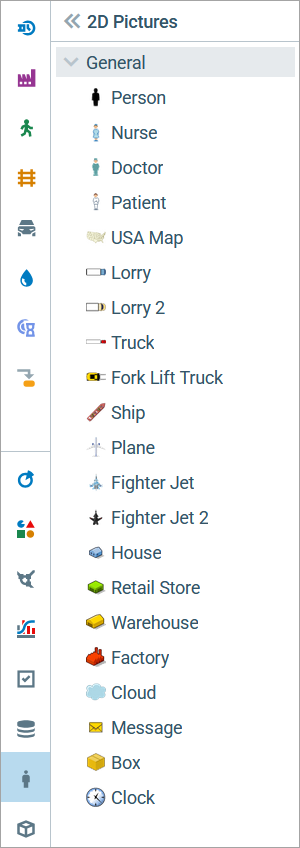The AnyLogic Process Modeling Library supports discrete-event modeling using flowcharts to represent agents, processes, and resources. Models built using this library are scalable, extensible, and support custom logic, animations, and integration of multiple modeling styles to capture real-world system complexity. Extension points allow dynamic behavior during simulation.
More elements available soon.
- Space Markup
- Blocks
-
Source
Sink
Delay
Queue
Select Output
Select Output 5
Hold
Match
Split
Combine
Assembler
Move To
Resource Pool
Seize
Release
Service
Resource Send To
Resource Task Start
Resource Task End
Downtime
Enter
Exit
Batch
Unbatch
Dropoff
Pickup
Restricted Area Start
Restricted Area End
Time Measure Start
Time Measure End
Resource Attach
Resource Detach
PML Settings
- Auxiliary
The AnyLogic Material Handling Library models manufacturing workflows and storage systems in detail, supporting factory layouts, transport routes, and complex processes. It integrates with the Process Modeling Library for deeper logic. Use it to optimize layouts, improve throughput, refine scheduling, and plan new equipment like AGVs, conveyors, or ASRS.
The AnyLogic Pedestrian Library simulates pedestrian movement in spaces like stations or streets. Pedestrians navigate continuous space, reacting to obstacles and other people. Models utilizing this library combine environment (walls, services, queues) with flowchart-based behavior, enabling analysis of density, wait times, and layout issues under various load conditions.
- Space Markup
- Blocks
The AnyLogic Rail Library models rail systems of any scale, from yards to subways. It supports detailed layouts, car dimensions, and train dynamics with high-performance simulation. Rail models integrate seamlessly with pedestrian, truck, and process models. Key inputs include track topology and operational logic, enabling accurate analysis and optimization of rail operations.
- Space Markup
- Blocks
The AnyLogic Road Traffic Library simulates detailed vehicle movement in highways, streets, factories, or parking lots. It offers high-performance physical modeling and integrates with Process, Pedestrian, and Rail libraries, allowing combined simulations with trucks, trains, ships, and other systems.
- Space Markup
- Blocks
The AnyLogic Fluid Library models storage and flow of fluids, bulk material, or large item volumes without tracking individual units. It uses blocks like Tank, Pipeline, and Valve, supports flow routing, and integrates with the Process Modeling Library. Flow is linear and optimized via an LP solver, offering high speed and accuracy.
- Space Markup
- Blocks
System dynamics in AnyLogic models systems at an aggregate level using causal loops, focusing on long-term behavior and policy impacts. It uses stocks, flows, and delays to represent changes over time. Ideal for strategic models, it trades individual detail for simplicity.
Statecharts in AnyLogic model complex, event- and time-driven behavior using states and transitions. Transitions are triggered by conditions such as timeouts, messages, or Boolean expressions. States can be hierarchical, allowing for detailed and structured behavior modeling. Statecharts provide a visual and intuitive way to represent an object’s logic, offering greater control over discrete behaviors than simple status indicators.
The Basic Elements palette provides components for defining agent behavior and structure to create and manage internal logic in simulation agents.
More elements available soon.
- General
The Presentation palette offers geometric shapes and elements for creating model presentations and animations.
More elements available soon.
- General
- 3D
The Space Markup palette includes elements like paths, nodes, and attractors to define spatial features and agent locations within models.
More elements available soon.
- General
- Material Handling
- Pedestrian
- Rail
- Road
- Fluid
Contains charts, data sets, and other elements used for collecting, viewing, and analyzing output data.
More elements available soon.
- Data
- Charts
The Controls palette provides interactive elements like buttons and sliders to enable user interaction within models.
Contains tools for integrating data sources, such as text files and Excel files.
More elements available soon.
- General
The 2D Pictures palette contains ready-to-use scalable vector graphics for various objects, such as people, vehicles, or buildings. These shapes can be dragged into the graphical editor, scaled, recolored, modified, ungrouped, and controlled via code for easy model visualization.
- 2D Pictures

The 3D Objects palette contains 3D shapes for objects like people, machines, or buildings, so you can create 3D animation without manual drawing.
- 3D Objects

-
How can we improve this article?
-


